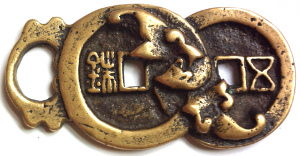The Chinese love visual puns.

A bat on a Chinese cash coin means “happiness is before your eyes”
The old Chinese charm displayed at the left is a good example.
The charm shows a bat on top of two coins.
Coins with the inscription wu zhu (五铢) were first used during the Han Dynasty (206 BC – 220 AD) and then produced during a number of dynasties until the beginning of the Tang Dynasty (618 – 907 AD).
Wu Zhu coins were thus cast for more than 700 years which made them the longest used coin in Chinese history.
For this reason, the two coins symbolize both “wealth” and “longevity”.
But to understand the deeper meaning of the charm, one must be familiar with a few simple numismatic terms.
First, the word for “coin” in Chinese is qian (钱) which happens to have the same pronunciation as the word “before” (qian 前).
Second, the square hole in the center of a cash coin is called a “yan” (眼) which means “eye”.
You will notice that the bat is on the coin’s square hole.
We can therefore say that “the bat is on the coin’s eye”. In Chinese this would be “the bat (fu 蝠) lies (zai 在) on the eye (yan 眼) of the coin (qian 钱)” or fu zai yan qian.
However, a bat symbolizes “happiness” to the Chinese because the Chinese word for “bat” (fu 蝠) sounds exactly the same as the Chinese word for “happiness” or “good fortune” (fu 福).
Therefore, saying “the bat is on the coin’s eye” (fu zai yan qian) sounds exactly the same as saying “happiness is before your eyes” (happiness (fu 福) is (zai 在) eyes (yan 眼) before (qian 眼).
The design of the charm cleverly includes a visual pun which conveys the auspicious wish fu zai yan qian meaning “happiness is before your eyes”.
One final note of interest concerning this charm. If you hang it vertically, which is the way it would normally be carried, the shape resembles a gourd which to the Chinese has a multitude of hidden meanings which I discuss in detail at Ancient Chinese Gourd Charms.
This is the left half of a belt buckle. The right half is identical in design but with a hook.